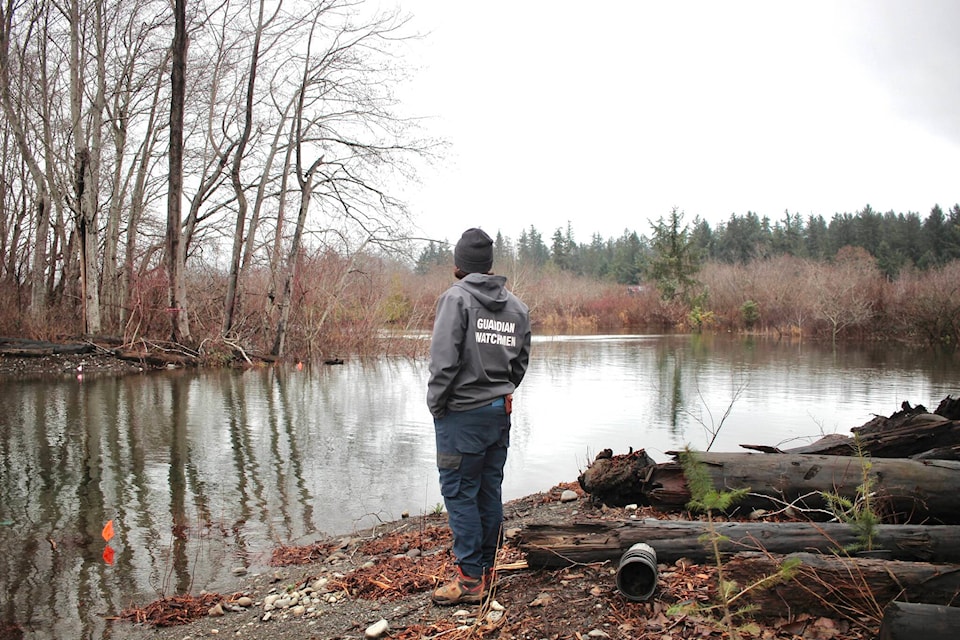In a few years, if all goes well, people won’t be able to tell that the Mill Pond near Baikie Island was once used for industrial purposes.
Greenways Land Trust and the Wei Wai Kum Guardians program’s vision of the pond is a lot different.
“I would expect like a canopy cover that’s gonna cascade from there,” said Wei Wai Kum Guardian Jordan Labbe, pointing into the trees surrounding the pond. “Then you’re gonna have a cascading terrestrial, you know, everything which starts from birds up here smaller vertebrates, and then you have the habitat for salmon.”
So, basically a complete 180 degree change from how it was a few years ago.
Campbell Riverites might remember the area as the location where logs were boomed for a mill operation. The area was taken from a natural one to an industrial one. Greenways Land Trust with their partners, particularly the We Wai Kum Guardians, have been working to change that.
“We’ve got access to some aerial photos from before it was altered by industry,” said Greenways Habitat Coordination Manager Camille Andrews. “It was very much what we’re aiming for, which is the the mixture of eelgrass salt marsh, then the terrestrial habitat, but with much more leaning towards eelgrass and salt marsh.
“When it was restored, it was still very compact in not very good soils. So all we had out here was blackberry and alder trees because they’re the beginning successional tree,” she said. “We cleared the alder and blackberry and all of that got chipped up … then that gravelly top compacted layer was pushed out into the Mill Pond … to create elevations in the water that are suitable for Eel Grass. And then after that, we re-graded all of the edge areas to make it suitable for salt marsh. The plan for all of the elevations was built using modeling that takes into account sea level rise.”
The project is one of three similar local projects that recently received funding from the province through the BCSRIF grant. It is a large-scope project to restore two hectares of the Campbell River estuary to a more natural state by recreating salt marsh and eelgrass habitats that were lost due to the industrial activity in the area. The project is a partnership with the Wei Wai Kum Guardians, and work has been underway for three years under a different funder, the Environmental Damages Fund through Environment Canada, and has now gotten more funding through the province.
The most dramatic work done so far has been the re-grading and construction on the former peninsula — which is now a series of small islands — and planting of native plants along the water’s edge. There’s been more work behind the scenes too.
“(Greenways’ Executive Director) Katie (Lavoie) and I are both trying to put a little bit of science into it,” said Andrews. That will including trying to figure out what kind of replanting work needs to be done by humans, and what would happen naturally.
“What I’m thinking about from my area is leaving some control areas to see what incidental plants what comes in on its own. How much effort we need to put into that, or is it possible for future projects to use the money elsewhere?”
Over the next three years, there will be more construction of goose fencing, planting of eelgrass within the pond itself, as well as environmental monitoring to ensure things are going smoothly. But one of the most important parts of the project is the partnership itself.
“It was an amazing opportunity to go from where on a lot of projects we were a presence on site, where as here we went to more of an active presence. We’re actually able to learn from mainstream biologists. It has proven itself time and time again that this is a real partnership,” Labbe said.
The funding was also able to help pay for Labbe’s certification as a commercial diver, which will have many benefits for the Nation going forward, as well as Lavoie and Andrews’ training as professional biologists.
As they were explaining the project, a few harbour seals popped their heads up in the pond. Aquatic birds were flying around the area, and though it was a king tide, the riparian plants were already starting to do their work of stabilizing the soil and shading and cooling the water. Right now, there are still a few traces of the industrial past of the area, but they’re getting harder and harder to see.
Soon, with any luck, it’ll be back to the way it was.
RELATED: Funding comes to three Campbell River fish restoration projects
Greenways Land Trust gets boots muddy in battle against Campbell River invasive species
